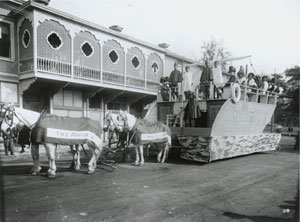Demonstration Papers: Parades, Pageants, and Power
The Territorial era was marked not just by the political shift of sovereignty from Hawaiian to Euroamerican control, but also by a shift in cultural control and hegemony. Euroamerican control was asserted politically and economically, but also socially and culturally. These years saw the institution of a series of public celebrations, which were at the time unique but have come to be representative of ethnic multiculturalism in Hawaii.

Beginning with The Mid-Pacific Carnival of 1904, a series of multiethnic public celebrations were staged as deliberate attempts to capitalize on the exotic nature of ethnic diversity in Hawai'i. These celebrations celebrated the multiethnic population of Hawai'i, featured Hawaiians, and were subject to the tourist gaze. Some were overtly characterized as celebrations designed to get visitors to come and/or extend their stays in Hawai'i. Others took advantage of the tourist audience and presented these congenial multiethnic celebrations as the embodiment of the aloha spirit.

Given the political trauma of the loss of sovereignty, with the massive increase in immigration from Asia, the decimation of the Hawaiian population due to disease and ill health, we should ask how Hawaiians are represented in these celebrations. Hawaiian values are consistently appropriated and provide the backdrop for the colorful display of ethnicity. The result is that Hawaiians themselves are not seen as having prior claim to the land, but are, rather, one of the many ethnic groups that comprise modern Hawai'i.

